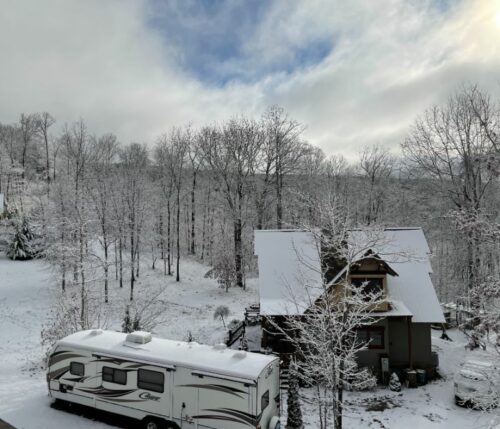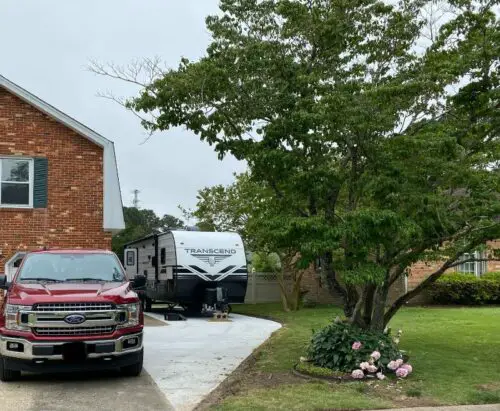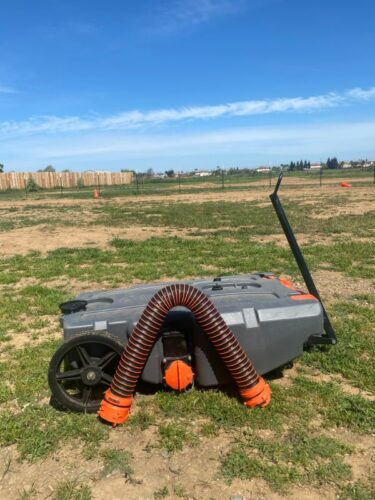If you’re dry camping in your RV, how do you power a CPAP machine? What if you frequent National Park campgrounds, which don’t usually have hookups? What about boondocking on BLM land?
You might be one of the 18 million Americans who suffer some degree of sleep apnea. And if you love camping, you might feel like you’re up a creek without reliable access to electricity.
Thankfully, you don’t have to leave your CPAP therapy machine at home (in fact, your fellow sleepers may insist you can’t).
Here are four strategies for camping off-grid with your CPAP machine.
WHAT’S A CPAP MACHINE, ANYWAY?

A CPAP therapy machine is used to treat persons suffering from obstructive sleep apnea. It regulates the air pressure in your throat so that your airway doesn’t collapse when you’re breathing.
(CPAP stands for Continuous Positive Airway Pressure, by the way.)
A similar machine is called a BiPAP machine. Rather than delivering a continuous positive flow of air, a BiPAP machine delivers air at two pressure settings: one during inhalation and one during exhalation. BiPAP machines are used for more severe sleep apnea and other respiratory conditions.
When used to relieve sleep apnea, CPAP and BiPAP machines come with a litany of benefits:
- Stroke prevention
- Daytime fatigue relief
- Heart disease prevention
… and CPAP therapy can relieve snoring (thank God!)
I’d hazard a guess that at least 50% of people reading this article are immediately concerned with stopping snoring rather than, say, stroke prevention.
And I get it. RVs aren’t built with acoustic insulation. A powerful snorer can transform an RV into a bass drum. If you or someone you love snores, then a CPAP machine may be the only solution to getting some sleep within 20 yards of each other.
WHAT YOU NEED TO KNOW BEFORE YOU GO

- If possible, bring a travel-sized CPAP machine.
- Preferable features are automatic altitude adjustment and humidification
- Out of respect for fellow sleepers, limit the noise to 30 db or less.
- Know your voltage and amperage requirements!*
- Some CPAP therapy machines can operate only off 120V power
- Others have dual 120/240V operation for US/international power
- And others also have the option for direct 12V or 24V DC input (no inverter required)
*This is confusing, I know. The truth is that the internal components of a CPAP machine usually run off 12V direct-current electricity. When you plug into a 120-volt wall outlet, a step-down transformer in the CPAP or power cord (that’s the “brick” in the cord) steps the line voltage down to the operating voltage.
However, not all CPAP machines can accept direct 12V input! It’s all in how they are wired.
So sorry for all the disclaimers! But CPAP machines really do come in a dizzying variety of configurations. So do your homework: Find out what options you have to plug in your CPAP machine.
1. CHOOSE A CAMPGROUND WITH POWER
If you need CPAP therapy and you are planning for a camping trip, then developed campgrounds need to be given priority.
You don’t need anything fancy. Most RV sites come with 30A 120V service. Motorhome sites come with 50A 240V service; tent trailer sites may come with 30A or 15A 120V service. Any of these power sources, once properly plugged into your RV, will energize your wall outlets.
Don’t forget to bring a backup extension cord! Limit the cord length to 25 feet to minimize voltage losses.
Advantages
- Most of the campsites that offer electricity are well maintained.
- There is no need to carry extra batteries if you are planning to camp in a campground that has power.
- No need to conserve power; there’s enough to share!
- Most of the campsites that offer electricity also have some extra perks like bathrooms, WiFi, and showers.
- Less risk of losing power in the middle of the night!
Disadvantages
- You need to search for other alternatives if you are planning to book a campsite during the weekends as they might already have been booked.
- Can’t camp off-grid! You’re stuck with KOA and Co.
- Can be crowded. So if you want peace of mind, look elsewhere.
2. FIRE UP A GENERATOR

A generator is an effective but crude option to power a CPAP machine while camping.
Fed by gasoline or propane fuel, a generator uses a small engine to create 120-volt AC power. With some generators, you can plug directly into an onboard outlet. With others, you’ll need to plug the generator into your RV power inlet (don’t forget the transfer switch!).
There’s no question a generator can produce sufficient power to run your CPAP machine while traveling. However, using a generator invites a number of other problems.
- First, the noise. Conventional generators are far too loud to run at night. You’ll need an inverter generator, which is much quieter. However, many campgrounds or dispersed camping areas prohibit running a generator at night, no matter how quiet.
- Second, the fuel and the fumes. All generators consume fossil fuels, usually at a rate of 1 gallon every eight hours or faster. And the exhaust pollutes the environment. You’re outside to enjoy the natural world; why spoil it at the same time?
- Third, the dirty electricity. All but the best inverter generators (e.g. Yamaha, Honda, Champion) produce “dirty” electricity. This typically shows up at harmonic distortion in the voltage waveform. Dirty power can damage the sensitive electronics inside your CPAP machine.
- Fourth, the weather may not always cooperate. Cold weather can make gas generators difficult to start. You don’t want your CPAP therapy to be subject to the whims of Mother Nature.
- And finally, consider the logistics. You have to cart around a 50+ lb generator, a gasoline canister, a power adapter cord, plus the CPAP machine itself!
Advantages
- Produces sufficient power to run a CPAP machine
- Can recharge your house batteries at the same time
- Works almost anywhere, anytime
Disadvantages
- Is loud! Sites usually restrict generator hours with enforced Quiet Time.
- Dirty electricity can damage sensitive electronics.
- Consumes and wastes fuel.
- Exhausts toxic pollutants and greenhouse gases.
- Heavy and awkward to cart around.
3. CPAP BATTERY PACK & UNINTERRUPTIBLE POWER SUPPLY
Yes, you can use a battery-powered CPAP therapy machine while camping!
Nowadays, CPAP machine batteries are far lighter and less expensive than in past years. They’re becoming quite popular.
Actually, let’s break up this option into three:
- CPAP machines with an integrated battery
- Portable Uninterruptible Power Supplies (UPS)
- Portable backup battery packs
No matter what option you choose, please remember that you need to double-check compatibility! You may need an adapter to connect your CPAP machine to your portable battery pack. Or you may need a separate inverter or converter depending on your power supply needs (e.g, 12V to 24V converter). Each manufacturer should have a compatibility chart.
Option A: Integrated Battery Pack
Many travel-sized CPAP machines come with integrated, dedicated battery packs, like the Z2 Auto CPAP with PowerShell.
These machines can’t run off just any battery; you have to use the built-in battery, which is recharged when you plug into regular shore power.
Most integrated battery packs are large enough to provide a single night’s worth of sleep (6-9) hours. This assumes no humidification, which will drastically reduce battery life.
Integrated battery packs are the easiest to use, since they don’t require any DC cable connectors, inverters, or other equipment.
Option B: CPAP Uninterruptible Power Supply
An Uninterruptible Power Supply is a battery that automatically kicks on if the power goes out. A UPS also filters power, ensuring the incoming voltage is within spec. It’s a great choice to power your CPAP machine while sleeping in your RV.
Unlike an integrated battery, a UPS isn’t built in. You plug your CPAP into the UPS with a DC connector cable, and then plug the UPS into a wall outlet. If you don’t have an energized wall outlet, or the power goes out, then the UPS battery provides the power.
UPS devices come in all shapes and sizes. The smallest and simplest versions can provide direct DC power only for 4-6 hours. The larger versions can provide enough power for 3-4 nights of run-time. Prices range from $200 at the low end to $350 in the middle to $700 at the high end.
Some battery power supplies offer direct DC output only in either 12V or 24V. Others offer modified or pure sine wave output as well. Again, double-check compatibility! You may need an inverter, converter, and/or adapter cable to connect a UPS with your CPAP machine.
Option C: Portable Power Bank
If you’re wondering what the difference is between a CPAP UPS and a generic “power bank,” that’s understandable.
Essentially, a CPAP Uninterruptible Power Supply is a medical-grade device that both filters and directs electricity. It has more advanced internal systems, allowing it to automatically switch the power source in case of a brownout or blackout.
A power bank is a simpler animal. It’s basically just a battery backup with built-in input and output ports. Advanced power banks offer 5V USB outlets, 12V high-amp socket outlets, 120V pure sine wave AC outlets, etc. Power banks can usually be recharged by being plugged into shore power, a solar panel, or a car charger. (I recommend you get one with pass-through charging capability.)
If using a CPAP therapy machine is critical to your health, you should use a UPS. If not, you might consider a power bank as a cheaper alternative.
Advantages
- Compatible with a range of CPAP machines
- Scalable, expandable power. Bring extra batteries for longer trips!
- Easily and quickly recharged
- Might be FAA-approved for in-flight use
- Can be recharged with solar panels
Disadvantages
- Can take a long time to recharge!
- Limited charging cycles
- Portable batteries are expensive
- Some lithium-ion batteries will generate extreme heat
- Lithium batteries can be subject to transportation safety regulations
- Humidification will drastically shorten battery life
4. DRAW POWER FROM YOUR RV HOUSE BATTERIES
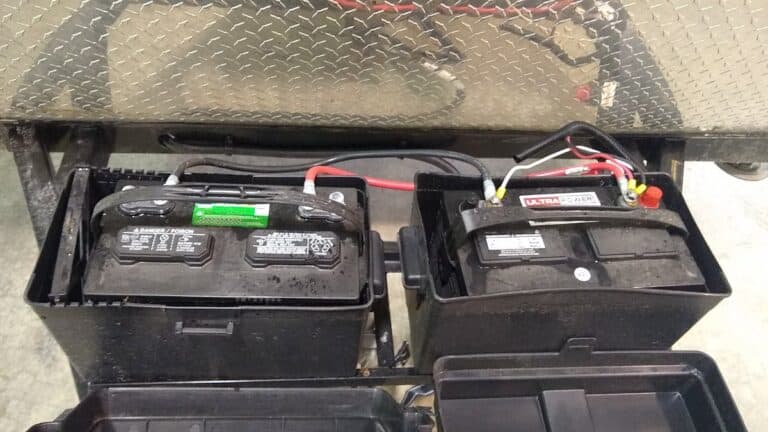
The simplest solution to power your CPAP machine is simply to rely on your house batteries.
At least, it sounds like the simplest. (And if you can plug your travel-sized CPAP machine directly into your RV’s 12V socket outlet, then yes, it probably is.) Unfortunately, for other models, it’s quite complicated to set up.
You Might Need an Inverter
For one, if your CPAP/BiPAP therapy machine doesn’t accept 12V DC input, you’ll need an inverter or converter to transform the power, such as a converter to 24V DC, or an inverter to 120V or 240V AC power.
Depending on the size of your CPAP and whether or not you’ll use humidification, you might be able to get away with a portable 150W “car charger inverter” that you can plug into a 12V socket outlet.
I recommend choosing an inverter at least 50% larger than the required input power of your RV CPAP therapy machine. If not, then you’ll have to hardwire an inverter into your RV’s electrical system, which is beyond the scope of this article.
Any inverter should be pure sine wave, not modified sine wave. The delicate components of your CPAP/BiPAP machine require clean sine-wave electricity to properly operate.
Plus, inverters aren’t 100% efficient. Expect to lose 20-40% of your power! Ouch! Standalone inverters have also been known to quit operating when they sense a severe voltage drop, which can happen if, say, your furnace kicks on.
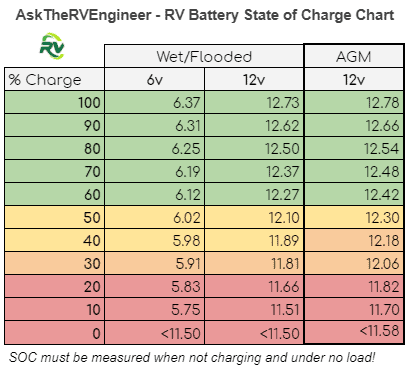
You Probably Need Deep-Cycle Batteries
If you’re going to run your CPAP machine off your house batteries, then you should be using deep-cycle RV batteries.
A lot of RVs come with marine/RV batteries. These are jack-of-all-trades batteries, which can be used for limited starting and medium-cycle applications.
You’ll get much better performance and lifespan out of a true deep-cycle battery. You have three options:
- Flooded lead-acid deep-cycle battery ($)
- AGM lead-acid deep-cycle battery ($$)
- Lithium (LiFePO4) deep-cycle batteries ($$)
I recommend you have a deep-cycle battery rated for at least 35Ah (50Ah or more is preferable) in order to run a CPAP machine.
You also have the option of purchasing a dedicated deep-cycle battery. Some RVers and campers purchase a small 35Ah lithium deep-cycle battery, stash it directly under their bed, and use it only to run their CPAP machine.
Please note if you plan to keep a battery inside your RV it should either be a lithium battery with a BMS or a lead-acid battery inside a vented battery box, vented directly to the exterior. This is for your safety to prevent a buildup of explosive gases.
Advantages
- Maximum capacity for longer camping trips
- Integrates all your power requirements
- Quiet, accessible, and portable
Disadvantages
- Can add substantial weight to your camper
- Inverters lose power through inefficiency
- Requires in-depth electrical knowledge to upgrade your system
- Can take a long time to recharge
WHAT ABOUT MY CAR BATTERY?
Now, I’ll rant here for a minute. There’s a lot of baloney online about how you can use an alligator-clips-to-socket-outlet to directly power your CPAP machine from your car battery.
There are so, so many problems with this idea! For one, only CPAP/BiPAP machines capable of running off direct 12V current will work when connected to a car battery.
And who wants to mess around with the hassle of routing cables from your sleeping area directly to your tow vehicle or motorhome’s starter batteries??
For another, unlike lithium-ion batteries, car lead-acid batteries don’t provide a constant voltage over their discharge cycle. The voltage starts high, somewhere around 12.8 volts, and drops down to 11.5 volts at “dead.” If you continue to discharge the battery, voltage will drop to 10V, then 9V, and so forth. Low voltage increases resistance. It’s a good way to fry the internal components of your machine.
It’s also a good way to ruin your car battery. Starter batteries, used in automobile and mobile home engine bays, are designed to “dump” a lot of power at once. They’re not designed for slow, steady, deep discharges. You can radically shorten the lifespan of your starter batteries by using them as a power source for your CPAP machine. And waking up to a dead battery is no fun!

This article was written with assistance from CamperLife.co, a website about camper lifestyle tips and RV guides and reviews.
Andy Herrick is a blogging nerd, #8 Enneagram, wannabe bread baker, INTJ, RV industry professional, and small business entrepreneur. He can be found hanging out with his lovely wife and family, skiing, cycling, climbing, hiking, and convincing anyone who will listen why dogs aren’t really that great of pets. Also, he runs this website.
-
Andyhttps://changingears.com/author/andrew-herrick/
-
Andyhttps://changingears.com/author/andrew-herrick/
-
Andyhttps://changingears.com/author/andrew-herrick/
-
Andyhttps://changingears.com/author/andrew-herrick/







